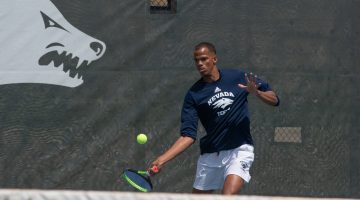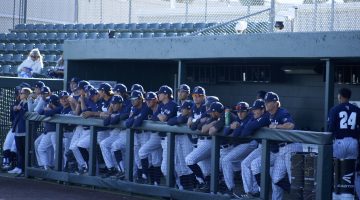By Marcus Lavergne

Marcus Lavergne/Nevada Sagebrush
University of Nevada, Reno, computer science major Nathan Griffin (left) and Ph.D. candidate Siming Liu (right) pose for a portrait in the Scrugham Engineering and Mines Building on Friday, March 4. Griffin and Liu work with artificial intelligence in the evolutionary computing systems lab to figure out solutions to different technological issues.
The ways by which humans complete daily tasks, and the operation of machines such as computers and vehicles, are constantly being innovated and improved through a seemingly endless stream of research, trials, failures and triumphs. It’s all being done in the pursuit of optimization, or making people, systems and machines as efficient as possible — essentially getting them as close to perfect as they can be.
In the University of Nevada, Reno’s Department of Computer Science and Engineering, optimizing how things function isn’t only happening in the real world, but the virtual world as well. Professionals and students there are working with artificial intelligence and specialized algorithms to access a potentially infinite network of ideas outside of the realm of human thought.
The late Stanford University emeritus professor John McCarthy defined artificial intelligence in his article “What is Artificial Intelligence,” as the science and engineering of making machines intelligent, or making those machines understand and recreate human intelligence. Diving deeper, McCarthy calls intelligence the “computational part of the ability to achieve goals in this world.”
That notion ties directly into the research being done by UNR computer science major Nathan Griffin and his partner and supervisor, research assistant professor Siming Liu. They work in the CSD’s evolutionary computing systems lab under Dr. Sushil J. Louie.
The team emphasizes the importance of discussing of special algorithms that have become a significant piece to accomplishing their own goals. They refer to them as genetic algorithms, which contain various sets of numbers.
The numbers, known as chromosomes, contain different behaviors, and the researchers place them in simulations where a problem has to be solved. Machines run those simulations, and eventually new behaviors begin to appear.
Griffin compares it to Charles Darwin’s evolutionary theories.
“From these simulations, we can have sort of a Darwinian selection picking and choosing which [chromosomes] do the best,” Griffin said. “Then, depending on which ones do the best, there should be a kind of cross-breeding going on that should evolve new behaviors.”
The simulations are run hundreds to thousands of times depending on the complexity of the problem. At times the outcome results in positive behaviors or new, viable solutions to each problem, and other times, negative behaviors impact the length of time for the simulation’s running phase.
Griffin said mutations created throughout the simulation may help with problem solving. In the chromosome, one of those mutations could appear as a single number within the set becoming a completely different number.
According to Griffin, candidate solutions or potential solutions known as individuals within the simulation may come to a certain behavior that’s good, but not the best route. When other individuals conform with that same behavior it can put the machine in a rut, or period where each of the solutions end up being the exact same, or very closely related to one another.
In other words, the solutions aren’t geared toward solving the simulated problem with the greatest efficiency. However, mutations might be able to fix it.
“In evolutionary computing, it’s possible to lose diversity,” Griffin said. “The mutation occurs very rarely, but it still occurs to provide some diversity in the case that [candidate solution] gets stuck. Mutations can help it jut out of that slump.”
These tests present vital information for Griffin’s present project, which involves improving unmanned drones and using genetic algorithms to get the machines to develop new, ideal behaviors for combat situations and mobility.
Liu, a Ph.D. candidate who’s already received a master’s in software engineering at China’s Hunan University Software School, supervises and helps with Griffin’s work, but he’s been heavily involved in his own research as well.
Liu delves more into the virtual world of video gaming. There, he’s using genetic algorithms in the pursuit of developing tactics and micro-behaviors that can adapt to players and beat them as well.
“Genetic algorithms are a tool,” Liu said. “To use this tool to solve some kind of problems, you need to play with it. That’s what we did.”
According to Liu’s dissertation from last May, his team was able to place its own bot, or unmanned player, into the game “StarCraft” where it performed better than the game’s built-in bots in several areas. “StarCraft,” and another game “SeaCraft,” act more as simulations for the U.S. Navy.
“We are trying to generate something that can play as good as human players,” Liu said. “That’s why real-time strategy games are hot in AI research. AI is making the right decision in the right place according to the existing knowledge.”
Liu relates the research to improving the operation of motor vehicles. Google is now working on perfecting its driverless car, and Liu is expanding his expertise by delving into creating more intelligent, safer automated traffic and transportation systems. There, he’s optimizing the instruction provided by traffic signals.
“Having the best performance or beating your opponent is not the only goal here,” Liu said. “[Having] different objectives and using the same tools, you can solve different problems.”
Humans don’t have the answer to every problem, and through different algorithms and simulations, computers can find solutions that humans haven’t considered, and they’re doing it faster according to Griffin. That’s the important part.
“Instead of trying every possibility for a certain amount of time and just seeing how we can go, we try to generate things that maybe make more informed decisions with less information,” Griffin said.
There are times when the process isn’t smooth though. There are situations when the programs solve situations by exploiting errors in the simulation — one might call it cheating the system. Also, the genetic algorithm can’t function outside of the simulation testing it. It becomes a useless set of numbers. This can place limits on the team’s research.
Still, the potential for AI seems almost limitless. In a time when problem solving and optimization appear to be an emphasized goal for universities and companies like Google, students like Griffin and Liu are holding the reins of progress. In the near or distant future, those reins may not even require the grasp of human hands.
Marcus Lavergne can be reached at mlavergne@sagebrush.unr.edu and on Twitter @mlavergne21.









